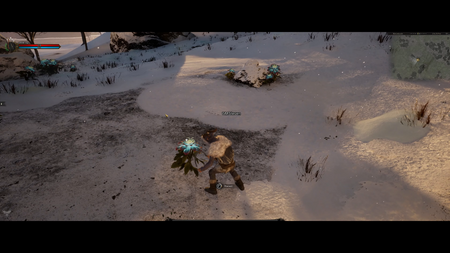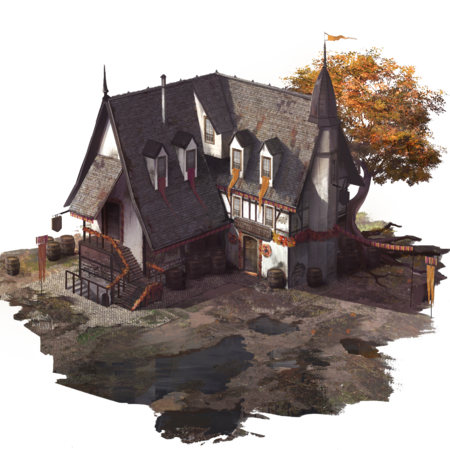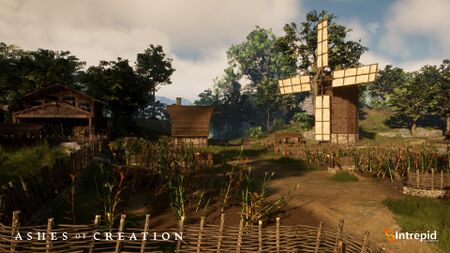Crops
Crops are harvestable resources in Ashes of Creation.[2][3][4][5][6]
- Freeholds allow placement of farm workstations for farming crops and livestock.[2][2][3][4][7][6][5]
- The level and types of processing stations on a freehold will affect the speed and quality of crop rotations.[8][2]
- Static housing allows placement of small garden sections for farming special types of crops.[3][4][9]
- Apartments allow placement of pots to grow seeds.[10][4]
- Public spaces in nodes allow lower-tier animal husbandry and farming activities.[11]
- There'll be different types of tools and/or machinery that can be used to plant multiple seed types within a particular infrastructure that gives you bundles and/or many different harvestings that's part of progression. So, as you get more adept at farming, you have the ability to mass produce; and the same is true when you talk about quantity, speed of processing across many of the different processing professions[8] – Steven Sharif
- Crops are grown from seeds that are obtained from vendors or in the open-world.[12][2]
- Initially seeds will need to be planted individually, but the acquisition of farming tools or hired farmhands will enable more efficient methods.[13]
- Crops must be watered and fertilized until they are mature.[14][12]
- Plants can be uprooted, fruited (seeded), or harvested.[14]
- There are diminishing returns from harvesting crops, where new seeds will eventually need to be reacquired from the world.[15]
- There won't be a breeding mechanic associated with crops.[16]
- Farmable crops have applications beyond basic food items.[17]
- Farmed materials can be processed into craftable materials or be converted directly into consumable items through professions such as cooking and alchemy.[3]
List of crops
Seeds
Crops are grown from seeds that are obtained from vendors or in the open-world.[12][2]
- Initially seeds will need to be planted individually, but the acquisition of farming tools or hired farmhands will enable more efficient methods.[13]
- Plants can be uprooted, fruited (seeded), or harvested.[14]
- There are diminishing returns from harvesting crops, where new seeds will eventually need to be reacquired from the world.[15]
Land management

As you draw resources from your surrounding area- what type of effect does that have on the land; and then also how effectively can you draw those resources without having such a deleterious effect on the land, which might impact future resource gathering for some period of time: And it makes relevant the movement of these players who are collecting these goods from the environment, that they actually cannot always just do so in one particular area, as the land management begins to degrade. So it actually encourages movement across the world to discover new areas that might not be as perturbed as the ones you're coming from. It's a very interesting idea. It's something that we're going to be prototyping in Alpha 2 and getting feedback on and testing.[19] – Steven Sharif
Land management mechanics are present for gathering artisans.[20][19]
- The spawn rate of resources in a given area is influenced by how players are interacting with those resources.[20][19]
- Drawing excessive amounts of resources may have a deleterious effect on the land health value for that area.[20][19]
- Actions like ridding an area of invasive species or performing crop rotations on freehold farms may have a positive effect on that area's land health value.[20]
- Defeating certain world bosses or mobs can positively impact the respawn rates of resources and animals in their vicinity.[21]
- It could be could be positive or negative, or both simultaneously. So the land health value ties into the health of a specific ecosystem; and the ecosystem can scale with different segment sizes of the world, or the world itself: A biome, maybe a node, maybe the player's freehold. And the things that a player does in those areas will contribute to health in a positive or negative way. So doing something like rotating your crops might increase the health of the land because that's considered something good to do; and maybe apprehending or removing poachers that are over hunting a certain species could be helpful to the health of the land. Maybe the mayor puts out a request for players to try and get rid of invasive species that are plants- maybe they're overgrowing weed and it's stopping other valuable plants from growing.[20] – Kory Rice
- The spatial inventory system is intended to mitigate the potential for players to diminish land management scores by stripping resources from particular zones.[22]
- There's a particular reason for why that inventory system is intended to exist within Ashes; and part of that is from the aspect of everything in the world is gatherable and there is a land management system that exists behind those gatherable things. The land management system takes into account how players are interacting with the environment: how many of the resources they're withdrawing from the world; and that decreases the spawn rate within certain localities as those things go too high. So there can be a degree of economic warfare by sending players out into zones where you want to mitigate collection of resources. You send your players out there to take all those resources and then that diminishes the land management score of that particular zone.[22] – Steven Sharif
Seasonal resources

If a particular region moves into a season and that week you can't grow a particular type of good, but another region halfway across the world can grow that good; and you talk about moving those goods across regions so that they're relevant to either craft workbenches or you can sell them in the local economies: That is a major indicator of movement of goods and movement of goods carries risks; and risks can create political foes and friends... Something as simple as just a climate can have cascading consequences across the entirety of the game.[24] – Steven Sharif
Seasons affect crops and other herbology resources available for gathering or planting, including how crop rotation is managed.[25][26][27][28]
- Seasonal variations in resource availability will impact the economy and necessitate the transit of goods between different regions.[26]
- One of the things that is huge about the season system and how it affects crops and the gatherables in the game is the impact it will have on the economy. When a particular area no longer is capable for a week's period of time, or even potentially longer, of producing a certain type of crop or harvestable; and that has to change across the world regionally, now the transit system of those materials of those gatherables they become more relevant, and they're subject to potential risk; and the prices might go up in certain areas. It is something that is actually very instrumental in the overall design of the economy in the game.[26] – Steven Sharif
- Seasons may not directly affect certain gatherables, such as veins of ore, but access to those resources may be blocked during certain weather conditions.[25][26]
- It won't likely affect too much on certain resource spectrums like veins of ore. Those might not be affected by the seasons or weather systems, but there might be blockages to cave networks that house those types of ore veins. Alternatively it is going to be significant impact on any type of herbology or plant-based types of gatherables. It's going to have significant impacts on crops that players can plant themselves on their properties; and that they'll be able to harvest. They're going to need to time the crop placement and its maturity window so that it's harvestable and available to be harvest before the change of seasons that might adversely affect certain types of crops. And not every biome will experience the same type of effects caused by the seasonality of the world. The desert biome might instead of snow have significant more winds that pick up that could be damaging to more fragile types of crops if you have a freehold in that location.[25] – Steven Sharif
Underrealm resources
Resources will be different in the Underrealm, including unique species of fish.[29][30][31]
- This will affect professions such as fishing, farming, and animal husbandry.[29][31]
- Since players may only have one Freehold, they must choose their Artisan specializations accordingly if they wish to place it in the Underrealm.[31]
Farmhands
Based on node type and progression, players will be able to hire NPCs to work as farmhands on their freehold farms.[32] Players will be able to command these farmhands in-game as well as potentially offline via an application (mobile app) or web interface.[32][33][34]
House plants
- House plants may be available as housing decor items.[4]
- Apartments will allow placement of pots to grow seeds.[10][4]
- Potted plants may yield unique items if the plant is properly maintained.[4]
Lore

While many families have humble gatherings amongst themselves during this time of the year, the Shadeless Tree is an ancient, venerated establishment that wishes to spread this joy to weary travelers. Here, merchants, adventurers, and citizens bereft of a place to be for the Verdant Keeper's feast may stay, exchanging stories, singing songs, and making friends. Though an already lively place to be, during the Keeper's celebrations the tavern is especially alight with joy and many are urged to join in the festivities - provided they do not rock the tavern, so to speak.[36]
The Verdant Keeper... are a sect of people that keep track of all the things that are necessary to have successful crops and to grow things and to make sure that the cultivation of these things allows a society or civilization to keep growing. So in the transition from Verra to Sanctus these people had to relearn how to grow things without magic. There were druid like people before and now we have to go to this place where there's no magic to support those things. So they spend their time learning about the world and learning about it in sort of a scientific way and keeping track of all of these seasons of the different years, of the decades, of the centuries that go by to sort of create a map for themselves and for the civilizations that they support: Kind of a means to be successful in growing crops and keeping people healthy and happy.[37] – Jeffrey Bard
As the months come and go, and the hand of winter looms over the land, various farmers of Verra take time to celebrate the fortune granted to them by the Verdant Keeper. Hearths are stoked, candles are lit, and fragrant delicacies are prepared. A massive celebration of food and drink takes place, marking the culmination of their hard work and preparation for the harsh, cold months to come. Should the celebrations go well, they say the Keeper will bless the next spring with a brand new harvest, ready to be plucked.[38]
Visuals
2023-07-01 2023-07-01
See also
References
- ↑ X.com - Verran screenshots.
- ↑ 2.0 2.1 2.2 2.3 2.4 2.5 Video, June 30, 2023 (6:39).
- ↑ 3.0 3.1 3.2 3.3 Interview, February 7, 2021 (42:41).
- ↑ 4.0 4.1 4.2 4.3 4.4 4.5 4.6 Livestream, October 30, 2020 (44:22).
- ↑ 5.0 5.1 Livestream, May 5, 2017 (32:11).
- ↑ 6.0 6.1 Livestream, May 30, 2017 (20:01).
- ↑ Livestream, October 16, 2017 (56:42).
- ↑ 8.0 8.1 Livestream, June 30, 2023 (1:47:33).
- ↑ Livestream, June 26, 2020 (45:32).
- ↑ 10.0 10.1 Interview, July 9, 2023 (41:22).
- ↑ Interview, July 9, 2023 (51:26).
- ↑ 12.0 12.1 12.2 Video, June 30, 2023 (11:53).
- ↑ 13.0 13.1 Interview, September 10, 2023 (29:31).
- ↑ 14.0 14.1 14.2 Livestream, June 30, 2023 (1:46:24).
- ↑ 15.0 15.1 Interview, July 9, 2023 (55:54).
- ↑ Interview, February 7, 2021 (44:17).
- ↑
- ↑ Video, June 30, 2023 (21:05).
- ↑ 19.0 19.1 19.2 19.3 Livestream, April 29, 2022 (25:16).
- ↑ 20.0 20.1 20.2 20.3 20.4 Video, October 28, 2022 (14:33).
- ↑ Livestream, May 31, 2023 (42:06).
- ↑ 22.0 22.1 Podcast, July 15, 2023 (22:57).
- ↑ Video, October 28, 2022 (19:10).
- ↑ Livestream, April 29, 2022 (56:24).
- ↑ 25.0 25.1 25.2 Livestream, May 27, 2022 (55:47).
- ↑ 26.0 26.1 26.2 26.3 Video, May 27, 2022 (15:50).
- ↑ Livestream, May 8, 2017 (20:27).
- ↑
- ↑ 29.0 29.1 Livestream, April 7, 2023 (27:30).
- ↑ Transcript, November 5, 2022 (10:46:47).
- ↑ 31.0 31.1 31.2 Livestream, June 1, 2017 (24:30).
- ↑ 32.0 32.1 32.2 32.3 Interview, July 9, 2023 (1:37:34).
- ↑ 33.0 33.1 33.2 Livestream, May 9, 2017 (28:57).
- ↑ 34.0 34.1 34.2 Livestream, November 17, 2017 (11:00).
- ↑ Livestream, September 24, 2021 (1:03:18).
- ↑ 36.0 36.1 Ashes of Creation Store: Shadeless Tree Tavern.
- ↑ Livestream, October 31, 2019 (14:13).
- ↑ Blog: Bounties of the Verdant Keeper.







